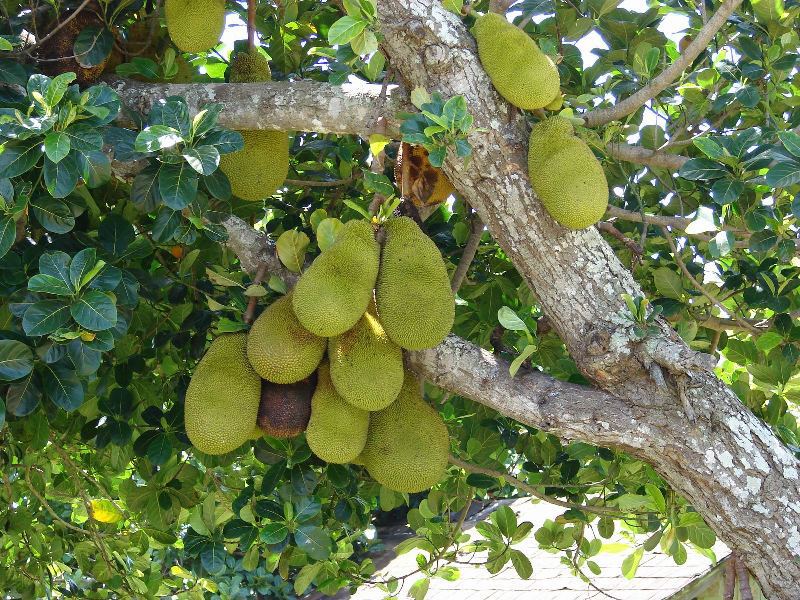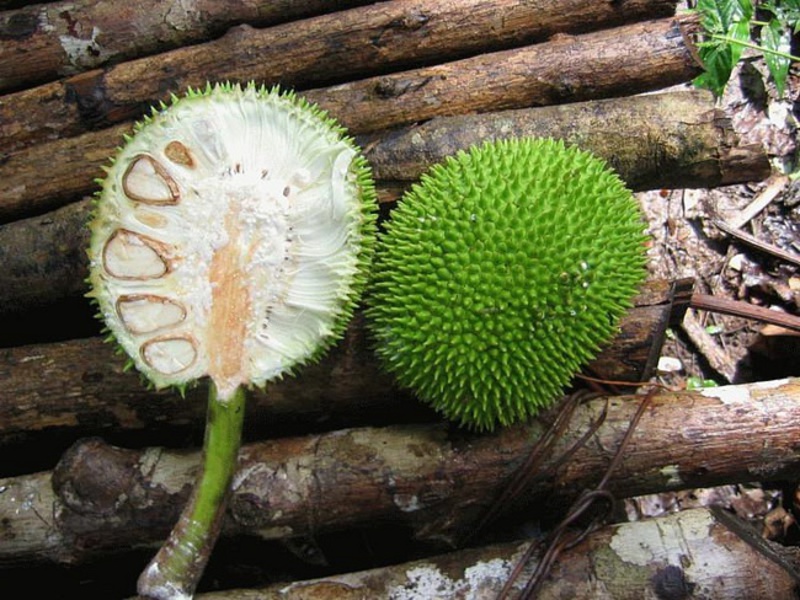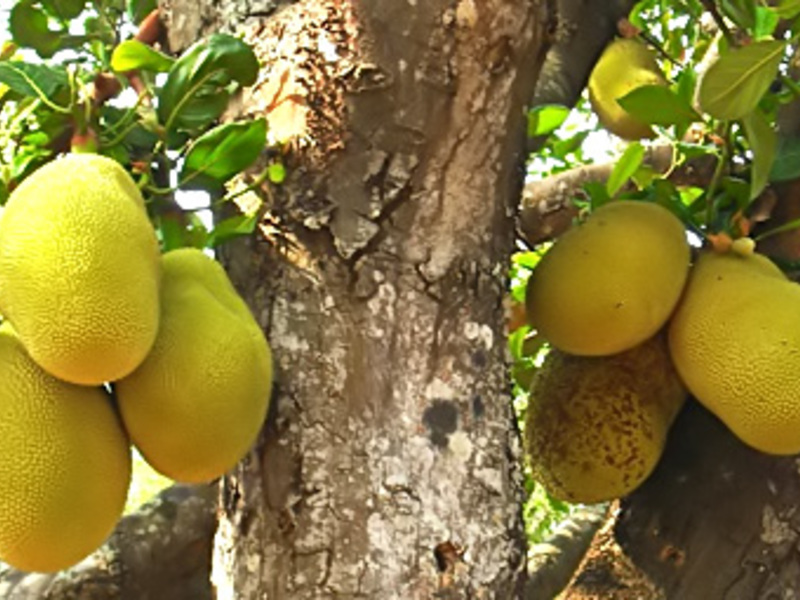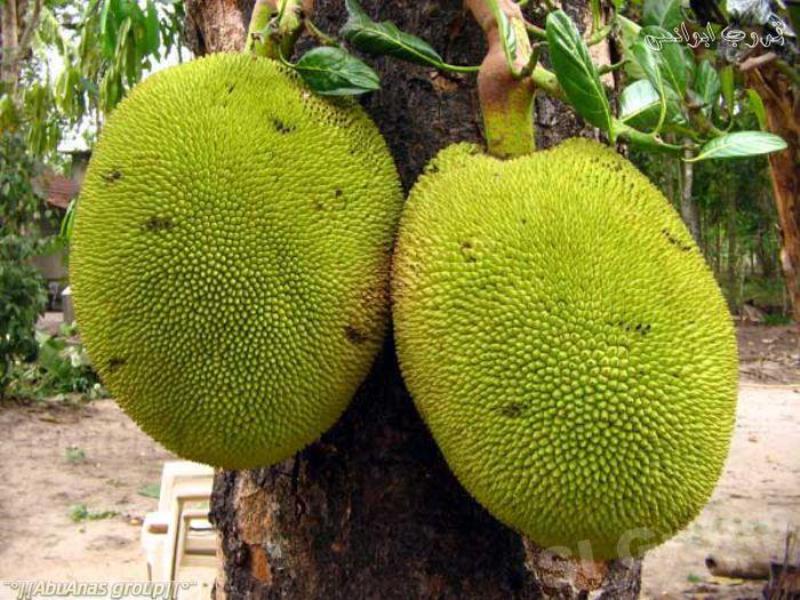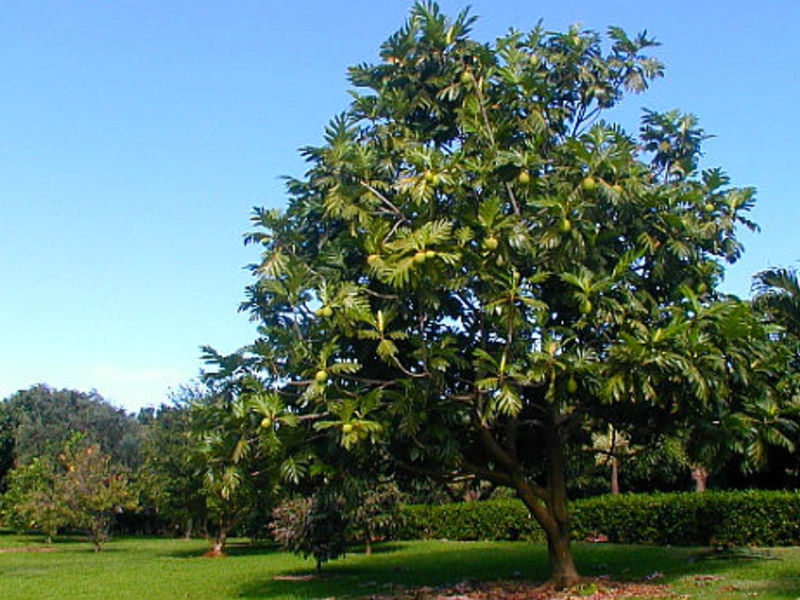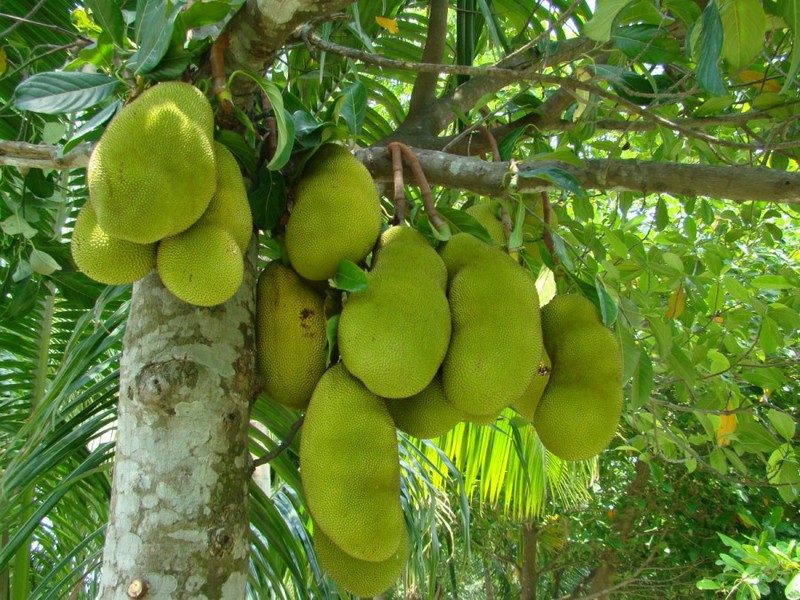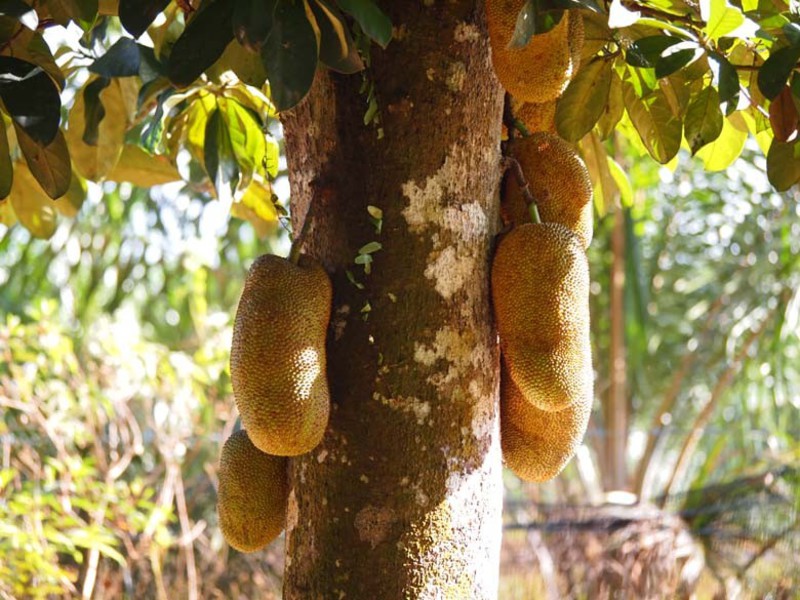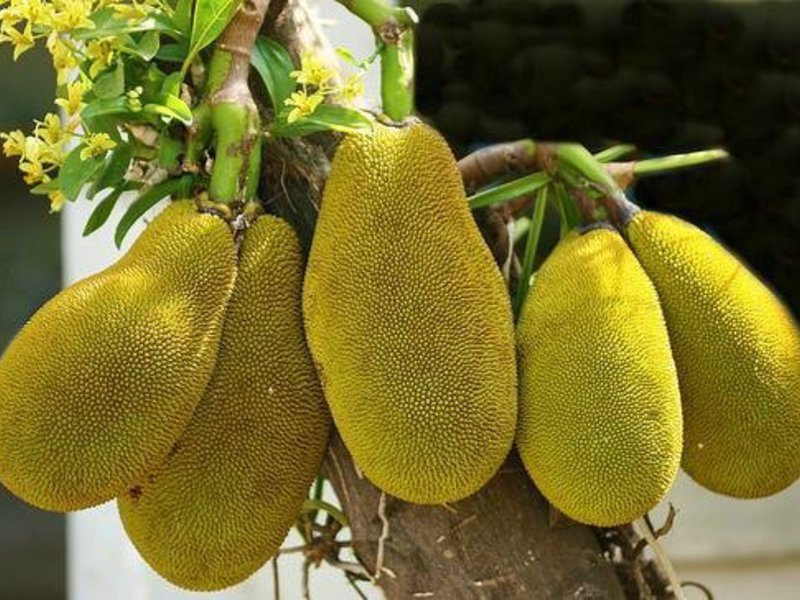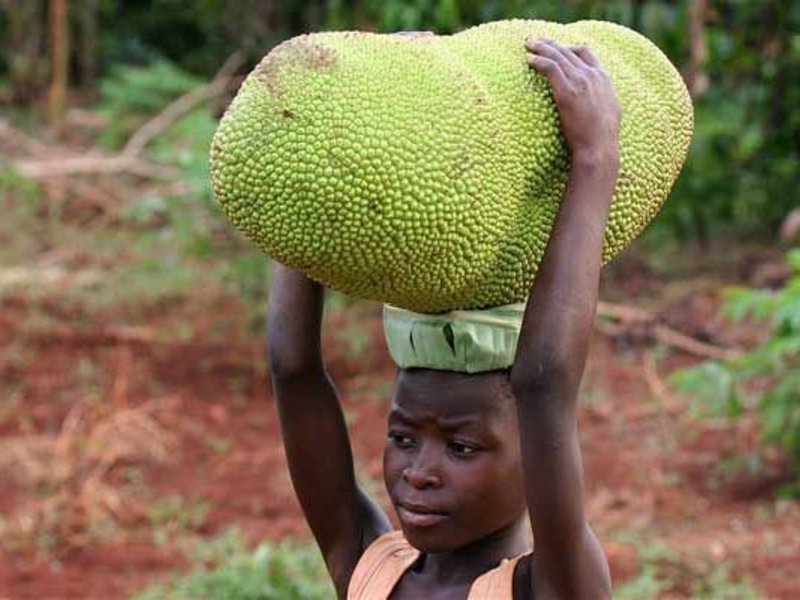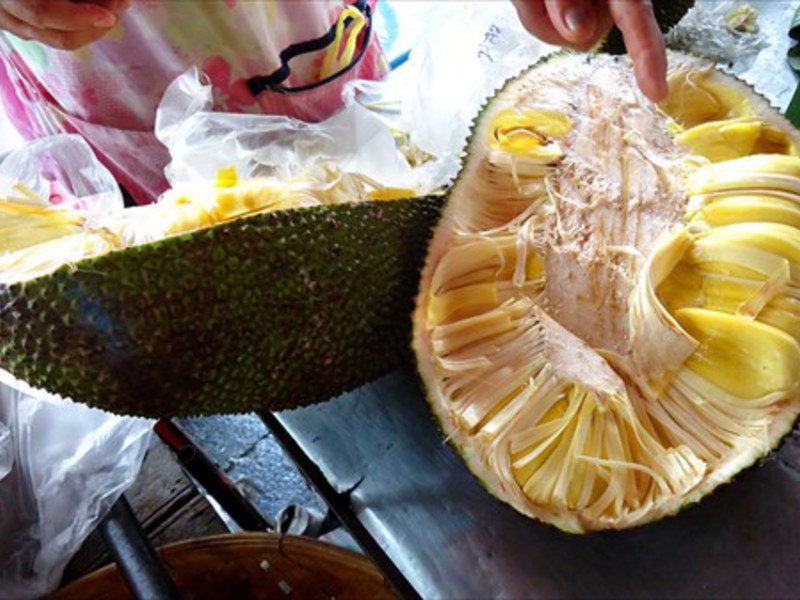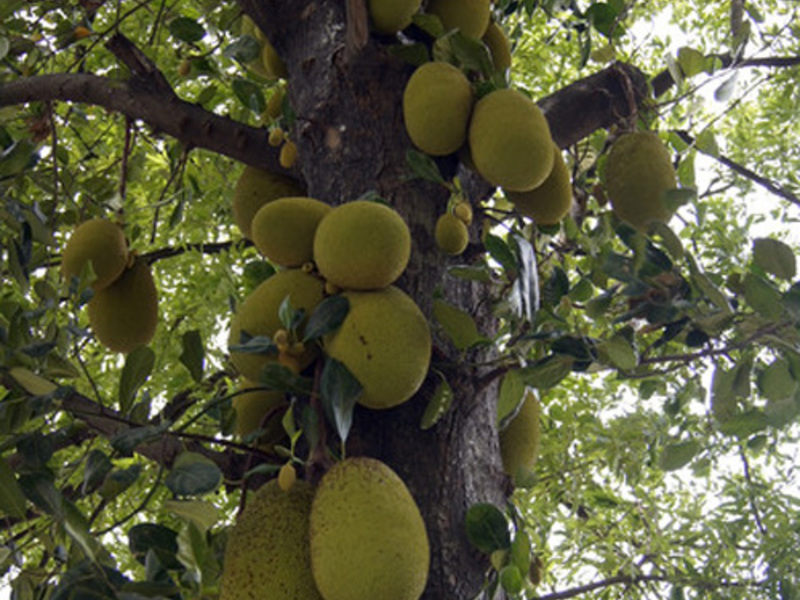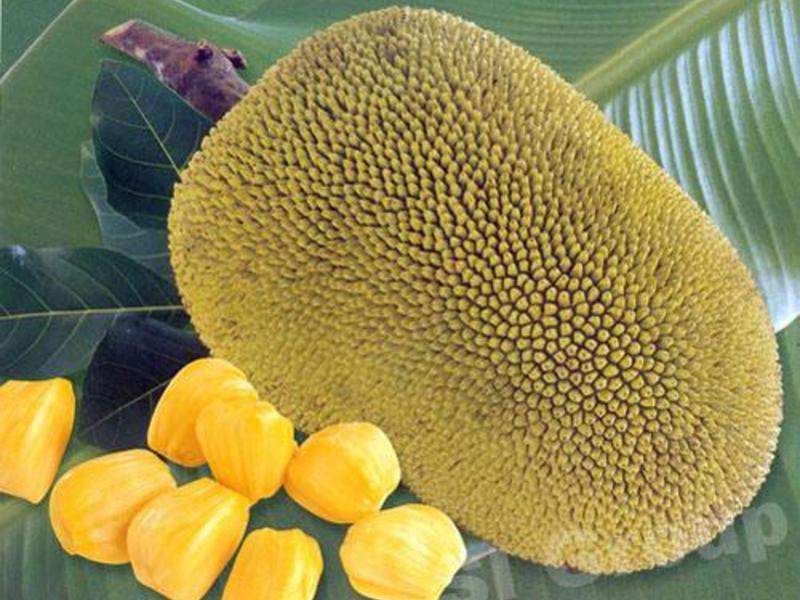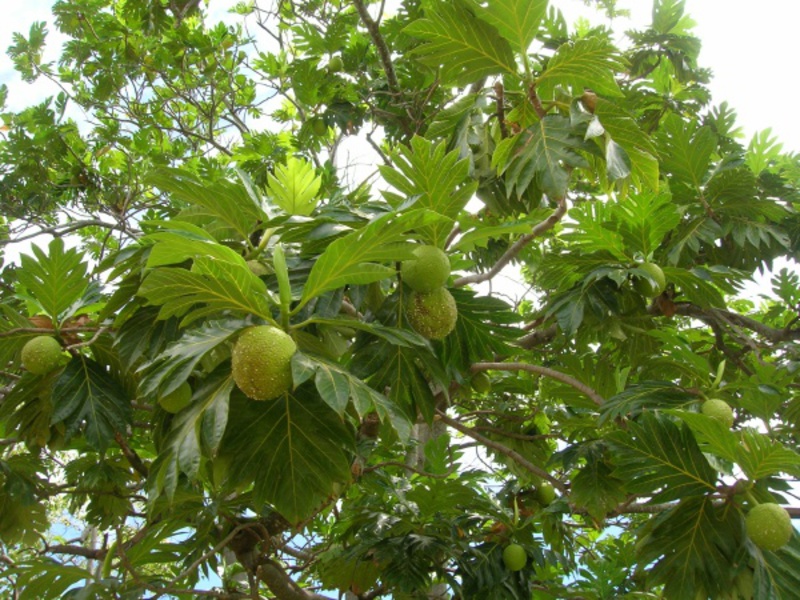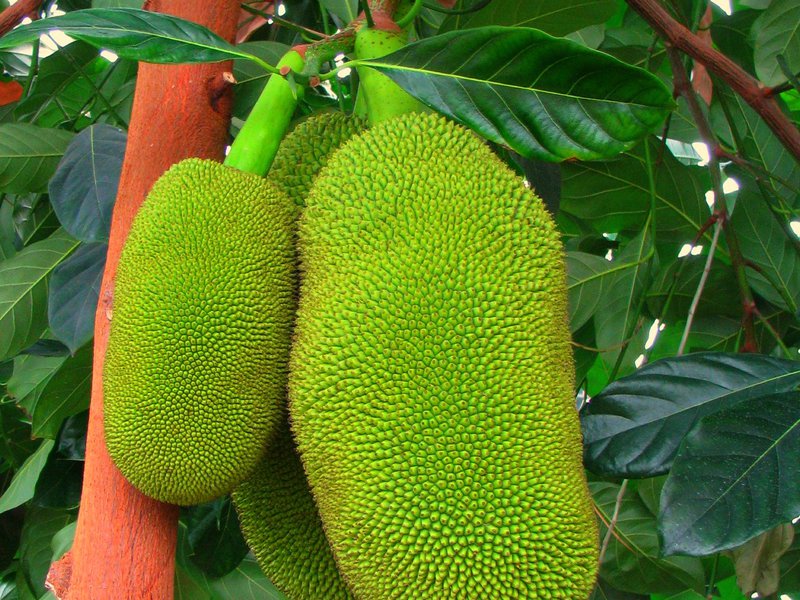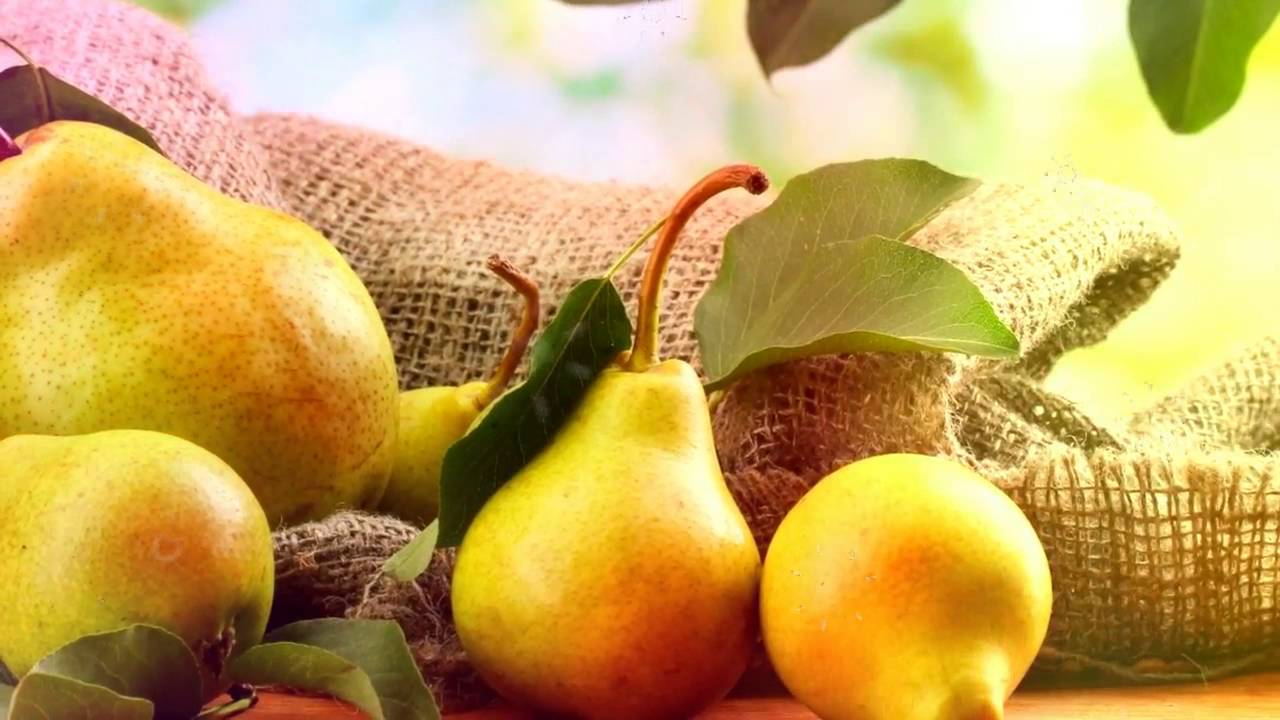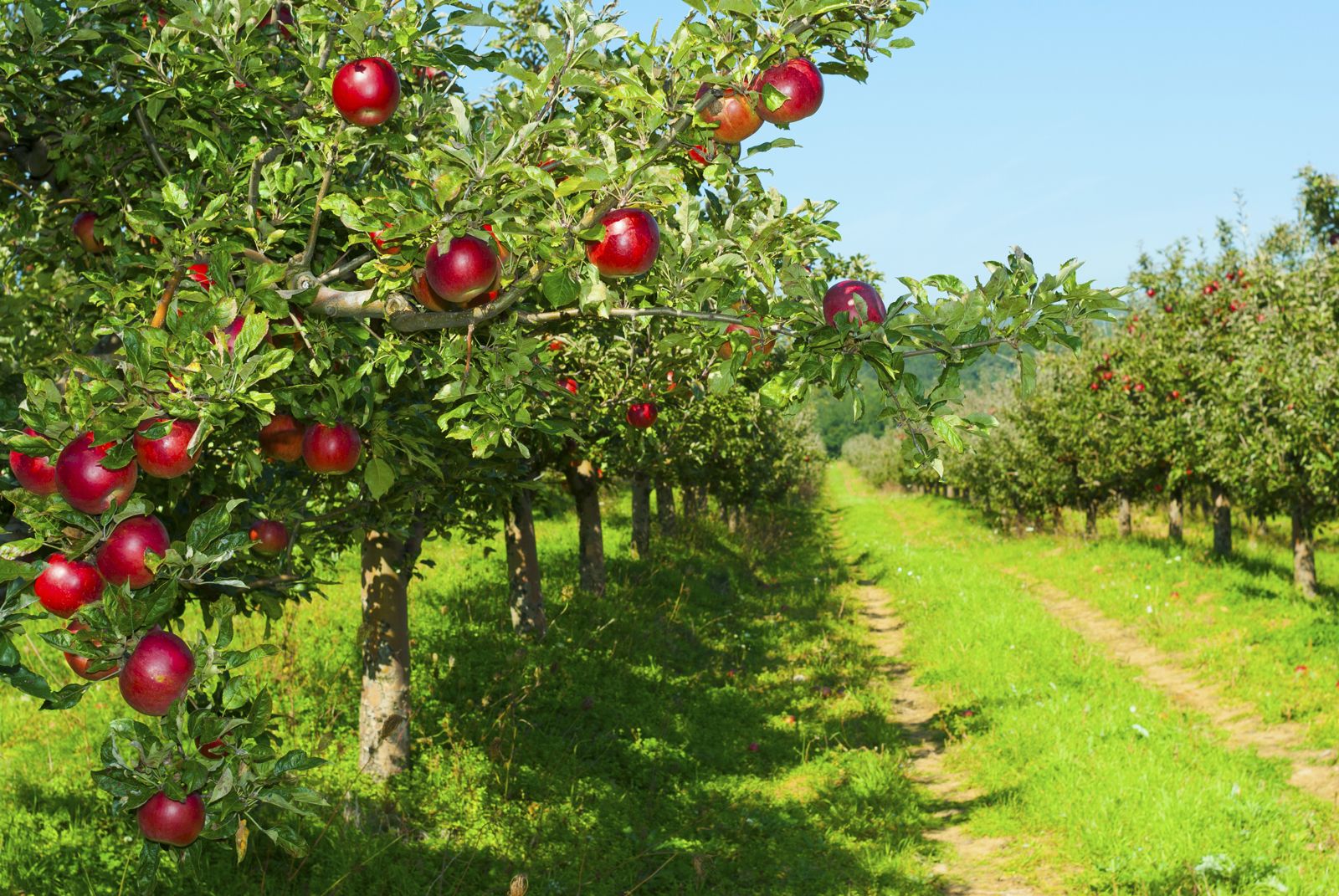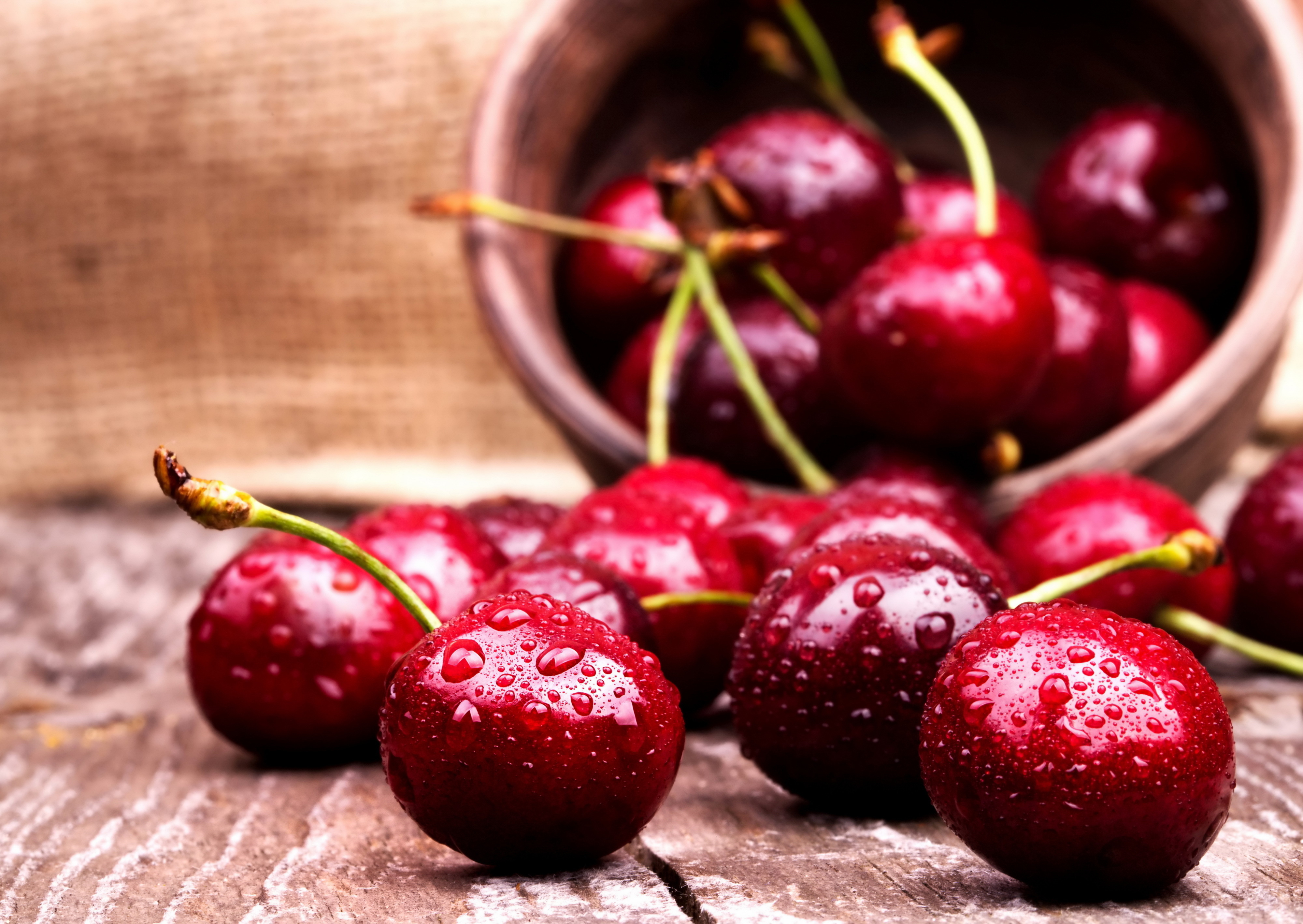To get acquainted with the breadfruit will certainly be interesting not only for experienced flower growers, but also for ordinary people. The birthplace of the tree is New Guinea, from where the Polynesians brought it to the islands of Oceania, after which the whole world got acquainted with this plant.
Content
Biological description of the breadfruit
In adulthood, the plant looks like powerful tree 26 m high... Its peculiarity lies in the fact that throughout its life it demonstrates a significant increase in height, while it looks like a breadfruit like an oak. The plant has a gray, smooth bark. It has branches that are thicker than the rest. This is due to the presence of leafy lateral branches. The main branches are thin and long, with bunches of leaves at their ends.
The variety of foliage gives the breadfruit uniqueness. Therefore, it is not uncommon for this plant to have both whole and pinnately dissected leaves, which appear earlier than the first. In addition, breadfruit leaves differ in the degree of pubescence. Climatic conditions are one of the key factors that determine the shape of the breadfruit - deciduous or evergreen.
In the presence of favorable conditions, the plant forms nondescript greenish flowers... The first to bloom are male flowers, which are presented in the form of long inflorescences-brushes. As for the female inflorescences, they look like large buds. Fruit bats act as pollinators for breadfruit. When the ovaries form, the female flowers eventually transform into a large fruit that looks more like a gnarled melon at the end of the season. The fruits may differ in the nature of their location on the branches: somewhere they are solitary, and somewhere they grow in the form of bunches.
A common feature is that every part of the breadfruit is made of sticky milky latex.
Breadfruit spread
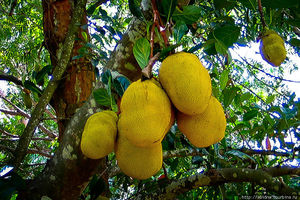 The first information about the breadfruit, the fruits of which are used by the aborigines of Polynesia as bread, appeared at the end of the 17th century. This information was brought to the whole world by the English navigator William Dampier. After a hundred years a terrible famine broke out in Jamaica, which forced the authorities to take an unusual step. It was ordered to start growing breadfruit to provide cheap food for slaves who are used as labor on the plantations. The solution of this task was entrusted to the frigate "Bounty", which went to the shores of the island of Tahiti for the seedlings of breadfruit.
The first information about the breadfruit, the fruits of which are used by the aborigines of Polynesia as bread, appeared at the end of the 17th century. This information was brought to the whole world by the English navigator William Dampier. After a hundred years a terrible famine broke out in Jamaica, which forced the authorities to take an unusual step. It was ordered to start growing breadfruit to provide cheap food for slaves who are used as labor on the plantations. The solution of this task was entrusted to the frigate "Bounty", which went to the shores of the island of Tahiti for the seedlings of breadfruit.
But the expedition failed, although the ship was able to reach its destination. The inhabitants of the New World were able to see live breadfruit only in 1793, thanks to the successful expedition on which the ship "Providence" went. This became the starting point of the history of the cultivation of this culture. The first people to taste the breadfruit were Fr. Jamaica and about. Saint Vincent. Following them, the population of other islands of the West Indies archipelago was able to taste the fruits. Today, inhabitants of many countries of the tropical zone are familiar with this plant.
Description of breadfruit
Based on the data available today, the breadfruit includes two main types:
- wild, whose fruits contain only seeds;
- cultural, in the fruits of which seeds are completely absent.
From the merits of this plant it is worth noting the high yield... For one year from one adult plant, you can get about 150-700 fruits. In terms of weight, this will be 500-2500 kg. If you create favorable conditions for the plant, then it can bear fruit throughout the year, arranging for itself a "rest" only for 3 months. A breadfruit can be harvested for 60-70 years. Also, this plant is distinguished by its rapid growth, showing an increase in height of 0.5-1 m per year.
During formation, the fruits are green, but the closer it remains until they ripen, the color begins to change, approaching yellowish-green. Subsequently, they turn yellow, and the most ripe fruits are considered to be yellow-brown in color. The size of breadfruit can be up to 30 cm in diameter, which in terms of weight corresponds to 3-4 kg. Unripe breadfruit is quite hard, and inside them there is a fibrous starchy white pulp. But as the moment of ripening approaches the fruits become softer, changes also occur with the pulp, which becomes creamy or yellow, as well as a sweet taste.
Success factors
Difficulties with growing breadfruit are associated with its moisture-loving nature. Therefore, its cultivation is possible only in regions where the minimum rainfall is 1000 mm per year. The plant is not afraid of periods of drought lasting up to 3 months. However, to ensure high yields, it is important that at least 25 mm of precipitation falls per month. A temperature above + 40 degrees oppresses the plant, it is not able to tolerate small frosts, which usually lead to its death.
Eating breadfruit
 For the inhabitants of the islands of Oceania, as well as some other regions of the planet, breadfruit is a valuable source of food. The pulp of ripe fruits is used for food, which is used in various forms - boiled, baked, dried and cheese... Sugar is also added to it, kneaded, ground, and then dough is made using it as a base for pancakes.
For the inhabitants of the islands of Oceania, as well as some other regions of the planet, breadfruit is a valuable source of food. The pulp of ripe fruits is used for food, which is used in various forms - boiled, baked, dried and cheese... Sugar is also added to it, kneaded, ground, and then dough is made using it as a base for pancakes.
Unripe fruits also have good taste. Many people eat ripe and sweet fruits that replace fruits. It is possible to understand whether the breadfruit is ripe by assessing its color, as well as the emitted drops of milk latex that cover the surface of the fruit.
As a result of frying, the fruits of the breadfruit change their taste and more resemble fried potatoes. Unfortunately, once removed from the fruit, the pulp must be used immediately. However, if you make crackers from it, then they can remain edible for several years. In order not to be left without food in a lean year, the inhabitants of Polynesia regularly prepare stocks from these rusks... For this, the peel is removed from the fruit, then they are divided into slices, after which they are tightly wrapped in banana and heliconia leaves. In this form, they are placed in a container and closed.
Over time, fermentation processes are activated in it, as a result of which a doughy mass is obtained from the pulp of the fruit. Its peculiarity is that it retains its original taste properties even after several years. However, this mass is not used in this form: it is placed in fresh heliconia leaves and fried in coconut oil.
The seeds can also be used as food. But first, they are heat treated, such as boiling and frying, and sprinkled with salt.
Useful properties of breadfruit
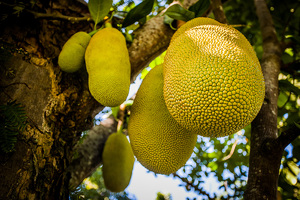 Dried fruit pulp is rich in many different nutrients: protein (4%), sugar (14%), carbohydrates (75-80%), most of which are starch.This pulp is higher in calories than regular white bread - 331 kilocalories per 100 grams... The pulp contains very little fat, the proportion of which is 0.2-0.8%. Breadfruit seeds have a different composition from fruits:
Dried fruit pulp is rich in many different nutrients: protein (4%), sugar (14%), carbohydrates (75-80%), most of which are starch.This pulp is higher in calories than regular white bread - 331 kilocalories per 100 grams... The pulp contains very little fat, the proportion of which is 0.2-0.8%. Breadfruit seeds have a different composition from fruits:
- carbohydrates - 34%;
- proteins - 15%;
- Fat - 29%.
Breadfruit is often used as livestock feed.
Fruits contain many nutrients, so in unfavorable years they can become a real salvation for the peoples of some countries.
Application in medicine
In addition to excellent taste, the fruits contain many different vitamins, which makes them even more valuable.
The pulp of breadfruit is very rich in fiber, therefore it is recommended to use them for people who have disorders of the gastrointestinal tract:
- constipation;
- dysbiosis;
- flatulence;
- bloating.
The benefits of fiber are its ability to remove toxins, metabolic products and bad cholesterol from the body. As a result increases immunity and burns excess fat... Also, this product is useful for the prevention of rectal cancer. If breadfruit is constantly present in the diet, this will minimize the risk of developing diseases of the cardiovascular system.
Conclusion
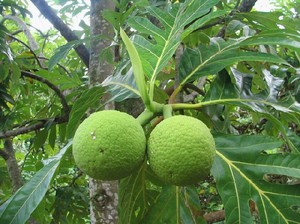 The breadfruit is an exotic plant that the inhabitants of Oceania first met, where it grows. It is of high value due to the fact that it can replace ordinary bread. Therefore, for the inhabitants of Oceania, its fruits have become a real salvation in lean years. Of the features of the tree, it is worth highlighting the fact that it is growing rapidly, gaining a height of 0.5-1 m in one year.
The breadfruit is an exotic plant that the inhabitants of Oceania first met, where it grows. It is of high value due to the fact that it can replace ordinary bread. Therefore, for the inhabitants of Oceania, its fruits have become a real salvation in lean years. Of the features of the tree, it is worth highlighting the fact that it is growing rapidly, gaining a height of 0.5-1 m in one year.
However, it is not so easy to grow it, since high humidity is a prerequisite for obtaining a fruiting plant. Breadfruit deserves attention not only because it can save you from hunger, but also because it contains a lot of nutrients. Therefore, they can be used for medicinal purposes to combat and prevent various diseases.
